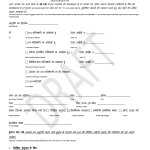Reasonable Accommodation Section 8 Form: What You Need to Know

Are you a landlord or a tenant wondering about the reasonable accommodation section 8 form? Well, you’ve come to the right place. In this article, we’ll break down the ins and outs of this form and what it means for both parties involved.
What is the Reasonable Accommodation Section 8 Form?
The reasonable accommodation section 8 form is a document used to request accommodations for tenants with disabilities under the Fair Housing Act (FHA). This law requires landlords to provide reasonable accommodations for tenants with disabilities, as long as the request is reasonable and doesn’t pose an undue financial or administrative burden.
Why is the Reasonable Accommodation Section 8 Form Important?
The reasonable accommodation section 8 form is important because it helps tenants with disabilities live safely and comfortably in their homes. For landlords, it ensures that they’re complying with federal law and avoiding potential lawsuits.
What Types of Accommodations Can be Requested?
Under the reasonable accommodation section 8 form, tenants with disabilities can request a variety of accommodations, including:
- Modifications to the unit, such as installing grab bars or widening doorways
- Changes to the lease agreement, such as allowing a service animal
- Accommodations in rules, policies, or procedures, such as providing a parking space closer to the unit
How Do I Fill Out the Reasonable Accommodation Section 8 Form?
Filling out the reasonable accommodation section 8 form can be a bit tricky, but don’t worry, we’ve got you covered. Here are the steps to follow:
Step 1: Identify the Tenant’s Disability
The tenant must identify their disability and explain how it affects their ability to live in the unit. This information will help the landlord understand the request and determine whether it’s reasonable.
Step 2: Describe the Requested Accommodation
The tenant must describe the accommodation they’re requesting, including any specific modifications or changes they need. This should include any supporting documentation, such as a doctor’s note.
Step 3: Provide Supporting Documentation
The tenant may need to provide supporting documentation to prove their disability and the need for the accommodation. This can include medical records, a doctor’s note, or other documentation that supports the request.
Step 4: Submit the Request
The tenant must submit the reasonable accommodation section 8 form to the landlord, along with any supporting documentation. The landlord will then review the request and respond.
What Happens After Submitting the Reasonable Accommodation Section 8 Form?
After submitting the reasonable accommodation section 8 form, the landlord will review the request and determine whether it’s reasonable. The landlord may:
- Approve the request and make the necessary accommodations
- Deny the request and explain why it’s not reasonable
- Request additional information or documentation to support the request
What Are the Rights and Responsibilities of Landlords and Tenants?
Landlords and tenants have rights and responsibilities when it comes to the reasonable accommodation section 8 form.
Landlord Rights and Responsibilities
- Landlords must provide reasonable accommodations for tenants with disabilities, unless it poses an undue financial or administrative burden.
- Landlords must respond to requests in a timely manner and provide a reason for denying the request.
- Landlords must keep the request and any supporting documentation confidential.
Tenant Rights and Responsibilities
- Tenants have the right to request reasonable accommodations for their disabilities.
- Tenants must provide supporting documentation to prove their disability and the need for the accommodation.
- Tenants must be respectful of the landlord’s time and property when requesting accommodations.
Common Mistakes to Avoid When Filling Out the Reasonable Accommodation Section 8 Form
Here are some common mistakes to avoid when filling out the reasonable accommodation section 8 form:
- Not providing enough information or supporting documentation
- Requesting accommodations that are not reasonable or necessary
- Not submitting the request in a timely manner
Conclusion
The reasonable accommodation section 8 form is an important document for tenants with disabilities and landlords. By following the steps and providing the necessary information, tenants can request reasonable accommodations to live safely and comfortably in their homes. Remember to fill out the form carefully and avoid common mistakes to ensure a smooth process.
Reasonable Accommodation Section 8 Form: What You Need to Know
<